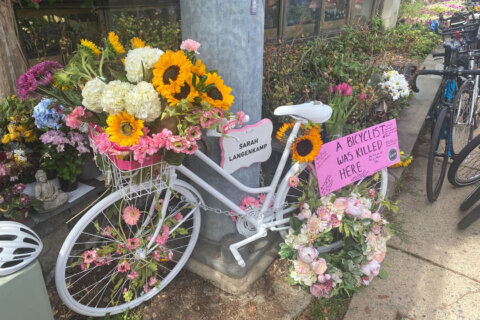
ROCKY RIDGE, Md. (AP) — A horse trailer pulled into the driveway of Linda Luster’s Rocky Ridge home on the morning of Oct. 1.
She and her husband were enjoying breakfast when they saw it. That’s when, Luster said, her husband shot her a look that asked did-you-buy-another horse?
In all fairness, Luster admitted, it wouldn’t have been the first time a horse arrived unannounced. After all, she spent years as a dressage horse trainer.
No, she assured him, this time the trailer contained not a real horse, but something even more special — a wooden carousel horse carved by renowned artist Larry Pefferly who had lived once in Rocky Ridge as well.
How it came to show up in Luster’s driveway that autumn morning is a story of friendship, artistry and love, and how one woman entrusted her family heirloom to an artist who would help fulfill her late mother’s dream.
The horse
Born in Washington, D.C., Pefferly grew up in Hyattsville, Maryland. His father was one of the lead sculptors who worked on the iconic flag-raising Iwo Jima statue.
After getting married to his wife Jerry in 1959, the Pefferlys settled in Rocky Ridge in 1963. They were avid fox hunters and raised and showed horses. Pefferly, who died in 2015, inherited the talents of his father, but he didn’t began making sculptures until he was 49.
Pefferly was most recognized for his hand-carved carousel horses. His pieces appeared in both public and private collections. And at the Eldridge Park Carousel in Elmira, New York, he recreated an entire row of 20 animals, as well as several for the inner rows.
Many would argue that his friend Sheila Graham Heider, who also grew up in Hyattsville, was the one who played an integral part in helping him find his passion when she commissioned a carousel horse for her home.
“They were dear friends and they grew up together showing horses in Maryland,” said Heather Heider, one of Sheila’s five daughters, during a recent telephone interview from her Leesburg, Virginia, home.
Pefferly and Jerry moved to Tennessee in 1980, but kept in touch with Sheila Graham Heider and her family, who relocated to Loudoun County, Virginia.
“Mom just knew of his talent and she said ‘Will you please make me a carousel horse?,’ and I believe hers was the first or the second one he ever did,” Heather Heider said.
Sheila Graham Heider worked closely with Pefferly so that the piece was personalized to their family. That included carving the family parrot on top of the saddle, and including the family’s landscaping business logo.
“He really custom designed the carving specifically on how she wanted him to look,” she said.
When Pefferly was finished, he carved the horse that Sheila wanted, which included a flowing mane, a bit in its open mouth, and its left front leg raised in a prancing stance, as well as other personalized touches like real horseshoes on its hooves. Most importantly, it is of authentic carousel horse size, which Heider estimated is as large as a medium-sized pony.
The original plan was for Sheila Graham Heider to paint the horse herself, and she started, but it did not work out. She died May 23 at the age of 81, which is when Heather Heider became the horse’s new custodian for its final journey to completion.
In the saddle
Over the span of 30 years — from 1980 to 2010 — Luster supplied her oil paintings for the covers of a magazine called The Chronicle of the Horse, an internationally-known publication based out of Middleburg, Virginia.
For a time, Heather Heider was the magazine’s publisher. Eventually, she left the magazine to grow her family, while Luster continued to train horses and gain a reputation for her fine art and oil paintings of animals with a keen focus on horses. About 10 years ago, Luster said, she stopped training horses to focus on her artwork.
Earlier this year, Heider reached out to Luster for an important project. Luster’s name kept coming up when she asked around for just the right artist to paint the carousel horse. Heider was looking for not just any artist, but one whom she could trust to realize her mother’s dream of painting the sculpture so that it truly looked like it could sit on a carousel.
Luster was the perfect fit. Not only did she have her extensive equine knowledge to lean on, but when she lived in Raleigh, North Carolina, she was the exhibit designer/artist for the North Carolina Museum of History. While she was there, the museum exhibited Charlotte Dinger’s collection of carousel horses. Dinger was known as the authority of carved horses.
“We did an exhibit around her horses, and I got really excited and hooked on carousel horses,” Luster said.
Luster did more extensive research and said she learned that “because they’re works of art” is signed on every one of the hand-carved horse.
“They’re not made out of a mold or anything,” she said. “They hand carve every square inch of the horse.”
Upon inspection, Luster found Pefferly’s signature on the Heiders’ horse’s belly as well as the date it was carved: 1986.
Painting the horse
Before she started painting, Luster did her research. That included discovering that Pefferly had written 2006’s “How to Carve and Paint a Carousel Horse.”
“So I pretty much followed his instructions,” Luster said. “He had some great advice.”
First, she had to prepare the horse for the new paint by removing the old paint that Sheila Graham Heider had started soon after it was delivered to her home. Luster said it took about a week of hand sanding, then she primed the horse and readied it for the colors.
When it came to paints, Luster decided to keep in the same medium she uses with her paintings: oil. However, with a roughly 10-week deadline, she was concerned.
“One of the things about oil paints, it takes a really long time to dry. And I was getting worried that I wasn’t going to have this finished by Thanksgiving,” she said.
Luster said Heider had some requests, such as wanting it to be painted like it was a dapple-gray, including the dappling across the hindquarters. To get the dappled look, Luster said she first painted it entirely gray then, while it was still wet, went back and added the effect. She said she had to focus on long stretches just on the coat alone, but she knew if the paint dried completely, she couldn’t do the dapples correctly.
“The days I painted the entire horse, I would work eight to 10 hours because you just got to keep on painting,” she said.
One thing she wanted to make sure was that the horse fit in line with a carousel horse by being ornate with vibrant coloring. Luster said she used gold leaf on the saddle and bridle. The horse also included a detachable tail made from real horsehair. Luster said she was able to clean off some of yellow tint that had developed from age. Once she was finished painting, Luster said she covered the entire horse with a satin matte varnish.
Luster said it was an exciting opportunity to spend so much time working with the three-dimensional object.
“Not only do I want to do it again, I want to advertise to let people know I can do this,” she said.
Returning it to the stable
Heather Heider and her husband Scott purchased her family farm in Loudoun County years ago from her parents, and even before they owned the home the carousel horse held a special spot in one room.
“The design of the house was actually done around the horse when Mom and Dad did the renovation originally. And then when Scott and I renovated it, we kept it the same way so that we were able to position it in our living room,” she said, noting it will probably be updated again to give the horse a better showcase.
The Sunday after Thanksgiving, Heider said she had an unveiling at the home with the horse back in its rightful spot. Her four sisters also flew in for the event.
“We had the unveiling for all of her friends, her best friends who were all part of the Maryland and Virginia horse community,” Heider said. “They all came to see the piece finally done.”
A few days before the reveal, the horse was delivered. It traveled home the same way it had been delivered to the artist: in the back of a horse trailer. Heider had just come back from a hunt and was dressed in hunting gear with her horses still in the trailer. All of that didn’t matter when she knew her mother’s horse had arrived.
“I walked into the living room, and I was in my boots and britches — and there it was,” Heider said, her voice cracking with emotion. “And I just wept. It was just so special to see my mom’s dream fulfilled — to have it painted and everything she wanted it to be.”
Heider said her mother’s reaction would have been the same.
“She would have been crying, too,” she said.
Copyright © 2024 The Associated Press. All rights reserved. This material may not be published, broadcast, written or redistributed.







